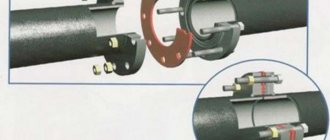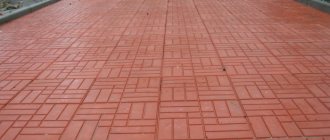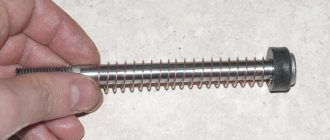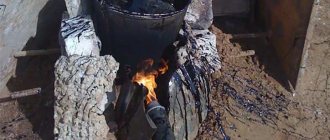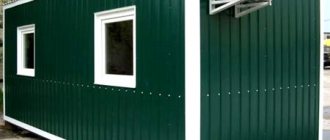Every owner of a plot of land sooner or later faces the issue of organizing convenient access to their territory and comfortable movement around it. For example, make a parking area in front of your house or pave paths so as not to stain your shoes with mud in rainy weather. The construction market today offers a wide range of coatings that can be used to solve any similar problem. One of these coatings is asphalt as the most popular and affordable.
In this article we have prepared recommendations for laying asphalt and applying markings.
About landscaping
Any coating has its advantages and disadvantages.
Asphalt is no exception. Its advantage can be considered the ability to use specialized equipment during the installation process. Please note that a concrete structure, for example, is laid only by hand, which is incredibly difficult. The main disadvantage of this artificial material is its strong odor. And all because the mixture contains bitumen, which under the influence of high temperatures begins to emit a pungent odor. This causes some discomfort.
If we talk about asphalt pavement, this process is quite complex. Strict adherence to technology is required. Please note that there are rules for each installation step. If all rules are followed, the finished coating will last for many years. It should also be added that a variety of techniques and equipment are used during the installation process. Therefore, it is not enough to simply attract experienced specialists and study the technology in detail. You must also have a license confirming that the company is authorized to provide the relevant services.
In addition, the contractor must know how to correctly calculate the thickness of the future floor, how to mark and carry out all the necessary work. He is also obliged to guarantee quality. This is very important, because each of us knows perfectly well how domestic companies like to save on this process. As a result, the road surface is destroyed in just one season.
General terms and concepts
The rules and requirements for the carriageway of the roadway are regulated simultaneously by several legislative acts:
- GOST R 54401-2011 “Public roads”
- SNiP 3.06.03-85 “Highways”, approved by Decree of the USSR State Construction Committee of August 20, 1985 N 133;
- KT-17.0-10.11-75 “Construction of asphalt concrete pavements”, approved by the Decree of the State Construction Committee of November 10, 1975;
- SNiP 2.05.02-85 and 3.06.03-85 “Highways”, etc.
The article uses the necessary terms and definitions to refer to the processes and materials used in the construction of roads and pedestrian streets.
Asphalt - for covering roads of varying intensity. This is a mixture of cement, crushed stone, sand, mineral powder and polymer components with the addition of bitumen resins as a binding element. It has greater strength and toughness than hot asphalt. The temperature must be controlled: during firing it reaches 200 ° C; during transportation and installation it should not fall below 130 ° C, otherwise the composition will begin to harden and accumulate, making it impossible to level and compact it.
Hot asphalt consists of concrete, crushed stone, natural sand, mineral dust and bitumen. No additives or polymers are added. It heats up to 130°C and can withstand at least 100°C. It is the optimal solution for pedestrian and bicycle loads, allowing it to withstand even short-term loads of several tons.
Asphalt concrete and hot asphalt are laid at a temperature of the lower base not lower than + 5 ° C.
Cold asphalt : all the same components, but with the addition of solvents to dilute the composition. It is recommended for emergency repair of the canvas at low temperatures - not lower than -10 ° C, at the lower base + 5 ° C, so that there are no cracks and the composition does not begin to freeze.
Liquid asphalt - used for pothole repairs, pedestrian and bicycle paths. It is produced with the addition of recycled asphalt granulate in an amount of no more than 10% for repair and construction and no more than 20% for surface leveling.
Areas of application
In addition to restorative pothole repairs on roads and parking lots, cold asphalt concrete is used in the following cases:
- Construction of a blind area in private housing construction.
- Construction of artificial ascents and descents.
- Framing road hatches, drainage grates and other metal elements on the canvas.
- Flat roof waterproofing.
- Filling potholes, cracks and expansion joints on the road.
- Laying garden paths and areas on private property.
Laying asphalt mixture around the hatch Source duna-spb.ru
What is asphalt made of?
Before we talk about installation, it is necessary to understand what asphalt pavement is made of. Asphalt is a mixture of bitumen and bulk materials - sand, crushed stone or gravel. Depending on the purpose of the road surface, the percentage of components may vary. For example, there is no point in using crushed stone for parking near the house, since it can withstand the high pressure required to cover public roads and highways. For ordinary routes and car areas, it is recommended to use up to 10% crushed stone due to the absence of a large load on the surface.
Sand, screenings or PShchS
They work like a cushion, that is, they provide a stable position, evenly distribute the weight of the top layers and prevent the asphalt from shrinking. Without a pillow, the upholstery will quickly deteriorate - cracks and holes will form on it.
The pillow will require a lot of material, so it is better to choose something cheaper. Sand or dither will work.
When it comes to sand, we recommend buying short-lived sand. This is the cheapest variety. As an option, you can consider quarry sand, but it is more expensive.
Crushed stone screening has an advantage over sand: it does not contain clay. The fact is that clay has the property of rising (that is, increasing in volume under the influence of low temperatures). This can lead to damage to the coating in winter. And screening is a product of crushing hard rocks. Therefore there is no clay in it.
There are different types of gratings: granite, diorite, serpentinite, gabbro, marble. Essentially, they will all work; Here the choice depends only on the price of the material and the cost of delivery to your facility.
Well, one more important feature: the screening can be increased. In its mixture, along with small grains, there are quite large ones. This is shown in the photo below. It will be more difficult to level such a coating. Therefore, before purchasing, be sure to tell the seller why you need sifting, and ask them to bring you a fine fraction - 0-5mm.
Well, the last option is a sand-crushed stone mixture (SSH). It's cheap, but difficult to work with. The mixture may contain both large and small grains, which makes leveling the top layer difficult.
Bitumen
Bitumen is a resinous product obtained from oil refining. It is a binding component of the asphalt mixture. The amount varies from 2 to 11% depending on the purpose of the road surface. The greater the load, the more bitumen contained in the asphalt.
Sand
Sand acts as a fine filler and allows you to evenly distribute the external load on the canvas. When preparing asphalt, only clean sand is used, since the final strength of the tape depends on it.
Crushed stone or gravel
As mentioned above, crushed stone is used to increase the resistance of asphalt to external loads. If it is planned to move more than 5 tons of equipment on a site, for example, when organizing the access of trucks to a construction site, a prerequisite is the presence of crushed stone up to 15 mm in the asphalt. This type of asphalt copes well with high tire pressure.
For curb asphalt, gravel 3-5 mm thick is used, which is an excellent damper and filler.
Geotextiles
The question will be asked whether the cars will drive on asphalt. Geotextiles give the coating additional stability and prevent shrinkage.
There is a huge amount of geotextiles on the market: garden, construction, industrial and so on. They differ in both density and properties. For example, a garden variety is intended to improve soil fertility and protect against weeds. However, it is not designed for high loads.
You should choose construction geotextiles with a density of 100 g/m2. This will be enough to equip a small parking lot or drive up to the site.
No. 4. A natural stone
Natural stone is a beautiful, durable but very expensive material
. If funds allow, then such a covering will be an excellent decoration of the territory and will emphasize the status of the owner. The advantages also include a variety of colors and textures of different species, complete environmental friendliness and resistance to precipitation, temperature changes and other negative natural influences.
Among the disadvantages
heavy weight, difficult to transport and lay, expensive, but the price range for stone is wide: sandstone and limestone, for example, are not as expensive as granite or marble.
In winter, a slippery ice film forms on the surface of the stone , which must be constantly removed mechanically, or the heating of the adjacent area must be used to prevent the formation of ice.
About the construction of asphalt roads and paths
Asphalt pavement can be made from different materials, but its quality directly depends on what materials were used and how the base was made correctly. For the places where the road will be laid, research and preparation of the structure are carried out, calculations are carried out and design is carried out.
For highways (about paths in the garden below), a standard set of materials is used:
- unpaved canvas;
- geotextile covering;
- layer of sand;
- layer of crushed stone;
- asphalt.
Separately, it should be noted that the crushed stone layer can include its different fractions, and bitumen concrete is laid in several layers at once, and the binder composition is bitumen or bitumen emulsion.
For paths in the garden or near the house, such a set of materials is not always needed. After all, the loads are small, but it is still necessary to prepare the surface for asphalt.
No. 8. Garden parquet
Garden parquet, also called decking
, is far from the most popular covering for the local area of your own plot, but it can still be used.
Among the types of decking are those that are made from solid wood
, treated with protective agents or temperature, and those that are obtained
from a mass of sawdust and a polymer binder
.
The first one is more suitable for terraces, but composite decking is a more or less suitable material for arranging a yard. Among its main advantages
:
- durability;
- resistance to high humidity and sunlight;
- corrugated anti-slip profile;
- ease of installation;
- quick drying;
- variety of colors and shapes.
Composite decking
, of course, is inferior in appearance and environmental friendliness to natural ones, but requires minimal care and is more resistant to negative environmental factors. This coating will cost slightly more than many analogues.
When can installation be done?
Hot asphalt is sensitive to weather conditions, so the best time for installation is spring and summer. In this case, the air temperature should not be lower than 5 degrees. Laying in the fall is also allowed, but at temperatures above 10 degrees. In winter, warm asphalt can be laid only at temperatures up to 0 degrees and a layer thickness of at least 4 cm. In addition, the mixture must contain surfactants or active mineral powders.
The surface on which asphalt will be laid must be dry and clean. Laying in the presence of puddles is not allowed.
So the hotter it is outside, the better. In principle, it is inconvenient to work in the rain, let alone lay asphalt.
Stages of preparing the base for asphalt paving
The technology for the correct implementation of an asphalt pavement cushion includes three stages:
- site markup;
- creating a foundation pit;
- formation of a foundation from crushed stone and sand.
Site marking
It is necessary to mark the future road, curbs, sidewalk and other elements on the site. At this stage, the issue of future load on the site is decided. The load depends on how many layers of material will be laid. For high loads, several layers of 15-20 cm will be required; for low loads, the thickness of the base will be 10-15 cm, and the asphalt itself will be 5-6 cm.
Creation of a pit
In order for the road to be at the same level as the general landscape, it is necessary to dig a foundation pit. The depth must be sufficient to accommodate the road cushion and asphalt surface. The average pit depth for low-traffic roads is 20-25 cm.
Formation of the base
The final stage of preparing the asphalt surface. First, the bottom of the pit is filled with crushed stone. This material absorbs water well, eliminating further shrinkage of the asphalt. Crushed stone of the central fraction is poured below. The bottom layer of gravel is placed in one corner to allow water to drain away. The crushed stone is compacted with a roller and a layer of sand is laid on it. Bitumen is placed on sand and pressed. Finally, fine-grained crushed stone is laid. All layers are carefully compacted and leveled. After preparing the base for the asphalt surface, workers move on to the asphalt surface.
The use of the most modern technical equipment in the asphalt paving process allows:
- properly prepare and lay the solution;
- minimize manual labor;
- automatically check all completed operations;
- ensure uniformity of the coating, its uniform thickness and level of compaction throughout the entire network;
- optimize work processes in general and reduce the final price by 1 m².
Other benefits of contacting us:
- competent organization of work processes, streamlined actions of the entire team;
- a clear schedule for supplying the mixture to the site, without delays or downtime;
- maximum mechanization;
- guaranteed quality result.
If there is soft soil on the asphalt surface area, it will need to be excavated up to 250mm deep to create pavement paths and up to 500mm deep to paved car parks or house entrances. The soil is compacted using a specialized roller. The process of preparing soft soil is quite labor-intensive, and any traditional material (crushed granite, construction sand) is used to create a solid foundation.
To install a rigid base under asphalt, builders use crushed stone, brick, concrete screed or reinforced concrete slabs.
To increase the service life of the pavement due to the technology of laying asphalt on soft soil, innovative geosynthetic materials are used to ensure:
• Life time; • Availability of excellent load-bearing capacity and prevention of mixing of the slope structure with the soil; • Resistance to aggressive environments; • Ease of laying the material; • Resistance to UV rays; • Environmental friendliness.
Asphalting a yard - how to lay asphalt with your own hands?
Excavation work
First of all, we pay attention to the area that will be prepared for laying asphalt. Do not forget about underground communications, vegetation with root systems and drainage systems. Large roots must be removed, otherwise they will lift the asphalt surface, disrupting its integral structure. Where you want to lay asphalt, remove the top layer of soil. In a small area, you can cope with improvised means by making a hole with a shovel. But paving a large section of the roadway requires the use of special equipment, bulldozers, and excavators. The thickness of the removed layer may vary. It all depends on the purpose of the paved area. If this is a path, then the depth of the pit can vary from 10 to 30 centimeters. If this is a roadway, it is advisable to dig deeper, counting on the passage of trucks. Excess soil must be removed so that during rain it does not erode the roadway, interfere with transportation, or clog the drainage system. it is necessary to provide for the installation of drainage. The water that appears during precipitation should not wash away the asphalt. The prepared soil is compacted with a roller.
Preparing the base for laying asphalt concrete
The base of the asphalt pavement must be durable. Therefore, we stock up on sand, crushed stone, gravel (not a rigid foundation for paving the site) or concrete slabs. When calculating how much it costs to paving 1 m2, take into account the consumption of the above building materials. For example, when using crushed stone of fraction 40-70, it will be necessary to pour a layer 15-20 centimeters thick on the access road. For a path - 5-10 centimeters. The building material must be evenly distributed and compacted well. In addition, you should prepare finer crushed stone (fraction 20-40 is quite suitable) and a fine grate. Evenly distribute the 10 cm thick layers one after the other. Pour sand (floor thickness 10cm). The sand floor must be watered and blotted by hand or with a roller. You can compare how much road pavement costs and choose a company for cooperation using a search engine that has collected a large database of construction companies. When the base is ready, you need to install the border. It plays both a decorative and functional role.
Laying asphalt pavement
This stage requires manual preparation of bitumen conglomerate or its purchase from a factory. Let us note in advance that it is extremely difficult to prepare high-quality asphalt at home. Therefore, the best solution is to buy the required amount of bitumen mixture at an asphalt plant or at the nearest Avtodor.” The advantages of purchasing factory-made asphalt are obvious:
- Firstly, the consumer receives a high-quality final product, saving time on the production process.
- Secondly, with a wholesale order, a discount and free delivery directly to the product are possible.
If you decide to install asphalt yourself, it is worth remembering that the bitumen mixture is laid at a temperature of at least 5 C in dry weather. Otherwise, the asphalt will lose its quality and it will be impossible to level and compact it well. There are hot asphalt and cold asphalt. So, hot bitumen mixture must be laid immediately after delivery to the site. The faster he goes, the stronger the road surface will be. Cold bitumen mixture is universal, as it adapts to any time of year.
Asphalt compaction
Timely compaction of asphalt pavement, ensuring its long-term performance. If the procedure is carried out independently, then you will need a vibrating plate, a double-drum hand roller or a light vibrating roller. If the asphalt mixture has cooled a little, it is necessary to make several passes with the roller for better grip and good resistance. To prevent the mixture from sticking to the equipment, first moisten the roller with water.
How much does it cost to lay asphalt?
The budget for asphalt pavement differs in each specific case. Consult with the manager of the company with which you began cooperation. He will calculate completely free of charge how much asphalt paving costs. A team of craftsmen specializing in the technology of laying asphalt and paving slabs will be sent here. For experienced craftsmen, laying paving slabs on asphalt is a familiar task, which they will perform as efficiently and quickly as possible.
Making asphalt at home
Asphalting is a task not only for capital construction, but also for individual construction. Each homeowner, if desired, can independently prepare the mixture for making a sidewalk, path or driveway on their own site. Typically, such asphalt pavements do not have to withstand high loads, so the production requirements are simpler. The finished asphalt has sufficient characteristics, so it will last more than a year without problems. Let's look at ways to prepare bituminous concrete yourself.
Classic method
The standard recipe includes the following “ingredients”:
- quarry or river sand;
- crushed stone 30-40 mm in size;
- bitumen (bitumen resin will do).
The container will be a metal bucket or barrel. Cook over an open fire, like a campfire.
Take gravel and sand (2:1 ratio), fill it with water and “boil” it over a fire with occasional shaking. At this stage, the bitumen base is prepared: the bitumen is dissolved in a bucket (it should boil), after which a plasticizer is added. If the latter is not available, you can use regular detergent or shampoo.
When the water in the crushed stone barrel boils, heated resin is added. Adding water is initially necessary so that the sand and gravel do not overheat above +100 degrees Celsius. Stir the mixture until the water comes to a full boil. Use hot ready-mixed asphalt.
Use of old asphalt concrete pavement.
A new mixture can also be obtained from old asphalt. The manufacturing technology is almost the same as for the new composition, with minor differences. If we are talking about large-scale production, then thermal profiling technology is used. This is when old asphalt is dismantled, crushed, loosened and melted.
The manufacturing process comes down to several stages:
- Using a sledgehammer or impact mechanism, the old canvas is removed. As a rule, the cushion is not disassembled; only a layer of bitumen is used.
- The old coating can be recycled. First, it is crushed into small fractions not exceeding 40 mm. The water is then drained and dissolved. Bitumen is added again, but in small quantities - 10 kg per 100 kg of old asphalt.
- The following steps are similar to making a new asphalt pavement.
Method of working with cold asphalt
This method is relevant when processing a large area is required. Not suitable for stitching. The production method became popular not so long ago, no more than 10 years ago. The principle is similar to cold welding. The main component is the bitumen itself, which can also be processed at sub-zero temperatures.
This fabric does not require heavy loads, so it is used for beautifying the local area. The advantage of the method is that it is applicable in situations where it is not possible to work with hot compounds.
Cons of the mixture
The technological accessibility and all-weather capability of the technology exceeds its following disadvantages by a margin:
- Due to the inclusion of plasticizers in the composition, the cost of the mixture (compared to traditional asphalt) is two to three times higher. The difference does not greatly affect the improvement budget; in private households, the technology is used to a limited extent.
- Water and dirt affect quality. If you choose to lay cold asphalt, be sure to thoroughly dry and clean the surface from dirt (especially important when laying it manually).
- A coating made from such a mixture does not withstand constant loads at high (summer) temperatures.
Asphalting the area in front of the gate Source grounde.ru
Asphalt compaction technology
In the process of compacting asphalt, the most important requirement is to carry out this procedure while heating the asphalt as much as possible.
- An increase in temperature of the order of 100 - 140 ° C leads to a decrease in viscosity; the roller applies tangentially oriented forces, overcoming resistance to shear formation. These conditions are most suitable for the compaction effect. The hardness of the asphalt binder increases as the mixture cools, increasing the force required for compaction. If the dough is at 70°C, it needs to be rolled three more times. This is necessary to overcome both the friction of sand and stone, and the forces pressing the stones to the bitumen.
- The presence of special equipment with working bodies that provide compaction allows the machines to independently perform compaction work. In this case, the most uniform coverage is obtained.
- The type of rollers used is determined by the design of the paver and the force with which pre-rolling was performed. Typically, additional compaction is carried out with 5-6-ton rollers or pneumatic machines.
- The time required for the procedure is determined by the thickness of the layer, the type of asphalt and the weather conditions in which the work is carried out. If work is carried out in cold weather at -10 ° C and below, it will take several minutes.
Test compaction report
This act is one of the types of technical documentation developed during road construction. This act is drawn up during the study and includes:
- name of the object and its abbreviated description;
- characteristics of the asphalt used;
- conditions under which compaction was carried out - temperature indicators of asphalt and the environment;
- asphalt paver parameters;
- lamination speed and number of passes;
- results of laboratory tests, measurements of coating dimensions, density and compaction coefficient.
The report is drawn up by laboratory employees and representatives of the manufacturer.
Asphalt laying process
The finished asphalt pavement must meet the requirements of the standards. In case of deviations at any stage, the roadbed will quickly deteriorate and costly repairs will be required. The main stages of work on laying asphalt pavement
- geodetic surveys - determination of soil composition, water depth, etc.;
- selection of the optimal type of asphalt taking into account the characteristics of the soil and the requirements of the roadway;
- selection of necessary equipment;
- determining the timing of commissioning;
- laying the road surface.
Necessary equipment
Road construction begins with preparatory work. First of all, the top layer of soil is removed, the roots of plants that can destroy asphalt are removed, and a drainage system is formed. The next stage of work is laying the foundation. They can be monolithic made of concrete, but this significantly increases the cost of road construction.
Typically, crushed stone laid in several layers is used as a base. The lower one is suitable for large crushed stones with stone sizes up to 70 mm. Its purpose is to drain groundwater. The intermediate layer, consisting of stones up to 40 mm in size, is designed to evenly distribute the load.
The top layer, the size of the stones in which is no more than 20 mm, increases the density of the top layer of the road surface. The actual paving is done by a paver. It is a track- or tractor-mounted unit with a compactor bar or screed attached to it, which can be static or vibrating.
The mixture is loaded from the van directly into the receiving hopper, from which it is evenly distributed across the width of the asphalt pavement using augers. Asphalt pavers come in a variety of sizes and capacities, so different tools can be used for different construction conditions.
The use of tracked vehicles provides a flat surface, and for narrow city streets modifications on wheels are more suitable. The width of the road surface is an important technical characteristic, the increase of which increases the savings of asphalt pavement.
For final compaction of asphalt, different mechanisms can be selected depending on the type of asphalt. These are light rollers up to 4 tons, medium rollers up to 6 tons, tandem and vibratory plates.
Required Personnel
Depending on the volume of construction work, the number of workers performing installation varies. Typically the following specialists are required for the job:
- paver driver;
- driver of a dump truck delivering asphalt;
- a team of road workers - 5-10 people.
Features of asphalt paving technology
The preferred time for asphalting is hot, above 10 degrees in autumn, above 5 degrees in spring. The only exception is renovation work. All asphalt mixtures according to GOST are divided into two groups:
- designed for installation at an ambient temperature not lower than + 5 ° C;
- fits within the temperature range from -25 to +5.
The process is the same, and heating of the asphalt can vary for different pavement thickness parameters such as asphalt and weather conditions. Do not lay asphalt in the rain. The wind speed at which the asphalt is laid also plays a role. The most important thing is to deliver the asphalt to the construction site at the required temperature, so this must be done as quickly as possible.
To achieve this, the process of loading asphalt into the paver is continuous. If dosing is interrupted, the remaining mixture from the hopper is not removed so as not to cool the doser. The silo is simply closed until supply is restored. At the end of the work, the mixture must be completely used up so that it does not remain either in the hopper or on the augers.
The asphalt paver moves at a constant speed of 2.5-3 meters per minute. When loading hot mixtures, the compaction bar remains on, but cold mixtures require it to be turned off. After the compaction procedure, the edges of the laid asphalt are trimmed and trimmed.
If, after work, unpaved strips remain in places inaccessible to the asphalt paver, it is allowed to lay the asphalt with a shovel and level it with metal rollers. Hand tools used for installation must be warmed up before use.
After laying, the asphalt is immediately compacted using rollers, vibrating units, etc. Damaged areas of the compacted surface are knocked down, covered with heated bitumen, re-filled with asphalt and compacted. During laying, the thickness of the layer is constantly checked and the temperature of the laid mixture is monitored.
Cost of work
The cost of laying asphalt includes the asphalt surface itself and a set of works to prepare the process:
- sending a specialist to inspect the workplace is possible free of charge or can cost up to 3,500 rubles;
- cleaning the soil under the roadbed is estimated at 320-420 rubles per square meter;
- construction of a concrete road base is estimated at 600-700 rubles per square meter;
- crushed stone base depends on the characteristics of crushed stone and can be estimated at 195-300 rubles per square meter;
- sand base prepared for pedestrian paths costs 100 rubles per square meter;
- the road curb is laid at the rate of 800-850 rubles per linear meter.
- paving over fine crushed stone costs 440-550 rubles per square meter;
- crushed stone-mastic base is estimated at 460-790 rubles per square meter;
- a sand floor costs 390-500 rubles per meter.
Asphalt pothole repair
Today, asphalt is the main material used in road construction. Various types of asphalt are used to lay highways, city streets and pedestrian paths. They also waterproof tunnels and roofs, and install floors. When patching in winter, a cold mixture is used, which is less dependent on ambient temperature parameters, and traffic movement ensures further compaction of the laid mixture. If repairs are carried out in the warm season, a thick hot mixture is used.
Pothole repair technology
The repair is simple, especially if the cracks and holes are small. Such repairs can be performed with hand tools using the following technology:
- the area that needs repair is marked;
- the marked places of damage are cut out along the contour with pliers, pneumatic hammers and jackhammers, and with a large working volume - with milling cutters;
- the holes are cleared of crumbs;
- the cleaned hole is treated with bitumen, which can be done with a self-priming device or manually;
- when processing large areas with trucks, it is advisable to provide hot asphalt, but if the degree of damage is small and these areas have a significant spread, it is better to use repairmen who ensure the mixture is warmed up and eliminate the risk of hardening;
- the mixture at a given temperature is poured into the prepared pit using an asphalt paver or manually. If the damaged area is deeply cut, then crushed stone is placed in it first. The asphalt is laid taking into account the next rolling;
- rollers and special equipment are used to roll out asphalt for processing.
Asphalt consumption
To calculate the consumption of the asphalt concrete mixture, the thickness of the layer required for laying or repair is taken into account, as well as the area of the area to be covered. The required asphalt thickness is determined by the purpose of the site. So, if it is necessary to asphalt an area for parking, it will be necessary to lay a layer of asphalt 4-5 centimeters thick, since the movement of heavy vehicles in this area is not planned.
To cover the entire area with asphalt you will need 10 m2 x 0.05 m x 2200 kg / cubic meter. In this formula, the last number is the density of the asphalt. As a result, we get the need for the mixture for laying the area in question - 1100 kg of the mixture. One cubic meter of asphalt contains about 2250 kg, so parking will take 1100 kg / 2250 kg = 0.49 cubic meters.
Proper placement of asphalt is as important to a good road surface as careful mixing and selection. If the technology is broken, the road surface will quickly deteriorate.
No. 6. Lawn covering
In a plot outside the city, where you want to take a break from the bustle of the city, asphalt and concrete, it is better to use natural materials, for example, lawn grass. Such a courtyard will look cozy, and the surface of the area will be in harmony with the plantings and the environment, however, it is better to take the most trampling-resistant lawn, but even it is better not to use it in the parking area - this is an option for recreation areas and places with the least load.
Among the minuses
lawn coverage requires constant care: fertilizing, pruning, weed control, reseeding in the most trampled places. But walking on the grass will be very pleasant, you can even move barefoot, and children will have a reduced risk of injury if they fall during games.
The following impregnation options are available:
- Asphalt emulsion. Of all the types, this is the most affordable mixture, but it does not always live up to expectations. Most often used for sections of roads without heavy traffic or sidewalks.
- Coal tar. A reliable base that also adds aesthetic appeal to the finished coating. Not affected by petroleum products and has a long shelf life.
- Acrylic polymers. Adding special components to the dough allows you to obtain an elastic and durable coating. It is also possible to change the color, which is used to further decorate the area.
When choosing a finishing layer, it is worth considering not only the financial issue, but also the main goal of the project. The choice of mixture must be based on how intensively the road surface is used.
Creating asphalt pavement is an important process, since the quality and durability of future roads and sidewalks depends on it. The classification of mixtures and the application process are determined by the requirements of GOST and SNIP, as well as the types of road work. In order for the coating to last as long as possible even under heavy load, it is important to choose a reliable manufacturer.

